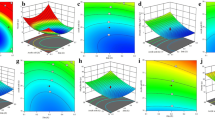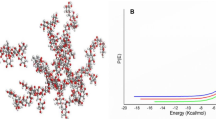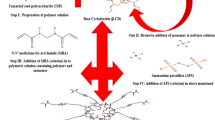Abstract
Breast cancer is a chronic disease that is characterized by an uncontrolled growth of abnormal cells from the breast tissue. It is one of the leading causes of mortality among women worldwide because of its early metastasis, aggressive behavior and resistance to the currently used anticancer drugs. Most of these drugs suffer from poor absorption and toxicity, and lack long-term efficaciousness because of drug resistance. Recently, polymeric thermosensitive hydrogels have emerged as excellent drug delivery systems for anticancer drugs with the potential to improve the overall therapeutic effect of the incorporated drug. In this current research, doxorubicin and curcumin were loaded into biodegradable PEG–gum acacia-based hydrogels. These hydrogels were pH-sensitive, biodegradable and non-toxic. The release mechanism of the drugs from the hydrogels was pH-dependent. In vitro cytotoxicity studies on MCF-7 cancer cell lines further confirmed that the incorporation of doxorubicin and curcumin into the hydrogels resulted in significant cytotoxic effect when compared to the free drugs, suggesting that these hydrogels are potential dual-drug delivery systems. The cytotoxic effect was dose- and time-dependent.
Graphical abstract










Similar content being viewed by others
References
Torre LA, Bray F, Siegel RL et al (2015) Global cancer statistics. CA Cancer J Clin 65:87–108
Mondal J, Panigrahi AK, Khuda-Bukhsh AR (2014) Conventional chemotherapy: problems and scope for combined therapies with certain herbal products and dietary supplements. Austin J Mol Cell Biol 1(1):1–10
Asghar U, Meyer T (2012) Are there opportunities for chemotherapy in the treatment of hepatocellular cancer? J Hepatol 56:686–695
Greco F, Vicent MJ (2009) Combination therapy: opportunities and challenges for polymer–drug conjugates as anticancer nanomedicines. Adv Drug Deliv Rev 61:1203–1213
Saraswathy M, Gong S (2013) Different strategies to overcome multidrug resistance in cancer. Biotechnol Adv 31:1397–1407
Deepa K, Singha S, Panda T (2014) Doxorubicin nanoconjugates. J Nanosci Nanotechnol 14:892–904
Wilken R, Veena MS, Wang MB et al (2011) Curcumin: a review of anti-cancer properties and therapeutic activity in head and neck squamous cell carcinoma. Mol Cancer 10:12–15
Misra R, Sahoo SK (2011) Coformulation of doxorubicin and curcumin in poly (d, l-lactide-co-glycolide) nanoparticles suppresses the development of multidrug resistance in K562 cells. Mol Pharm 8:852–866
Hui-TienLiu Yuan-SoonHo (2018) Anticancer effect of curcumin on breast cancer and stem cells. Food Sci Hum Wellness 7:134–137
Vallianou NG, Evangelopoulos A, Schizas N, Kazazis C (2015) Potential anticancer properties and mechanisms of action of curcumin. Anticancer Res 35:645–651
Tuorkey MJ (2014) Curcumin a potent cancer preventive agent: mechanisms of cancer cell killing. Interv Med Appl Sci 6:139–146
Thorn CF, Oshiro C, Marsh S, Hernandez-Boussard T, McLeod H, Klein TE, Altman RB (2011) Doxorubicin pathways: pharmacodynamics and adverse effects. Pharmacogenet Genomics 21:440–446
Patel AG, Kaufmann SH (2012) How does doxorubicin work? ELife 1:e00387
Vashist A, Kaushik A, Vashist A et al (2016) Recent trends on hydrogel based drug delivery systems for infectious diseases. Biomater Sci 4:1535–1553
Wu J, Zhao X, Wu D et al (2014) Development of a biocompatible and biodegradable hybrid hydrogel platform for sustained release of ionic drugs. J Mater Chem 2:6660–6668
Sinha MK, Gao J, Stowell CE et al (2015) Synthesis and biocompatibility of a biodegradable and functionalizable thermo-sensitive hydrogel. Regen Biomater 2:177–185
Wang Y, Chen L, Tan L, Zhao Q, Luo F, Wei Y, Qian Z (2014) PEG–PCL based micelle hydrogels as oral docetaxel delivery systems for breast cancer therapy. Biomaterials 35:6972–6985
Seib FP, Tsurkan M, Freudenberg U, Kaplan DL, Werner C (2016) Heparin-modified polyethylene glycol microparticle aggregates for focal cancer chemotherapy. ACS Biomater Sci Eng 2:2287–2293
Li M, Li H, Li X, Zhu H, Xu Z, Liu L, Ma J, Zhang M (2017) A bioinspired alginate-gum Arabic hydrogel with micro-/nanoscale structures for controlled drug release in chronic wound healing. ACS Appl Mater Interfaces 9:22160–22175
Sarika PR, James NR (2015) Preparation and characterisation of gelatin–gum arabic aldehyde nanogels via inverse miniemulsion technique. Int Biol Macromol 76:181–187
Giray S, Bal T, Kartal AM et al (2012) Controlled drug delivery through a novel PEG hydrogel encapsulated silica aerogel system. J Biomed Mater Res A 100:1307–1315
Jiang G, Sun J, Ding F (2014) PEG-g-chitosan thermosensitive hydrogel for implant drug delivery: cytotoxicity, in vivo degradation and drug release. J Biomater Sci 25:241–256
Singh B, Dhiman A (2017) Evaluation of gentamicin and lidocaine release profile from gum acacia-crosslinked-poly (2-hydroxyethylmethacrylate)-carbopol based hydrogels. Curr Drug Deliv 14:981–991
Shaikh MM, Lonikar MS, Lonikar SV (2014) Gum acacia-acrylic acid hydrogels: pH sensitive materials for drug delivery system. Asian J Res Chem 7:407–411
Huang GQ, Cheng LY, Xiao JX et al (2016) Genipin-crosslinked O-carboxymethyl chitosan–gum arabic coacervate as a pH-sensitive delivery system and microstructure characterization. J Biomater Appl 31:193–204
Cao H, Yang Y, Shao ZZ (2015) Doxorubicin hydrochloride and curcumin loaded silk fibroin/hydroxypropylcellulose hydrogels for localized chemotherapy of cancer. J Control Release 213:e8–e152
Barui S, Saha S, Mondal G, Haseena S, Chaudhuri A (2014) Simultaneous delivery of doxorubicin and curcumin encapsulated in liposomes of pegylated RGDK-lipopeptide to tumor vasculature. Biomaterials 35:1643–1656
Zhao X, Chen Q, Li Y, Tang H, Liu W, Yang X (2015) Doxorubicin and curcumin co-delivery by lipid nanoparticles for enhanced treatment of diethylnitrosamine-induced hepatocellular carcinoma in mice. Eur J Pharm Biopharm 93:27–36
Zhang Y, Yang C, Wang W, Liu J, Liu Q, Huang F, Chu L, Gao H, Li C, Kong D, Liu Q (2016) Co-delivery of doxorubicin and curcumin by pH-sensitive prodrug nanoparticle for combination therapy of cancer. Sci Rep 6:21225
Varaprasad K, Vimala K, Ravindra S et al (2011) Development of sodium carboxymethyl cellulose-based poly (acrylamide-co-2acrylamido-2-methyl-1-propane sulfonic acid) hydrogels for in vitro drug release studies of ranitidine hydrochloride an anti-ulcer drug. Polym Plast Technol Eng 50:1199–1207
Varaprasad K, Mohan YM, Ravindra S et al (2010) Hydrogel–silver nanoparticle composites: a new generation of antimicrobials. J Appl Polym Sci 115:1199–1207
Aderibigbe B, Varaprasad K, Sadiku E et al (2015) Kinetic release studies of nitrogen-containing bisphosphonate from gum acacia crosslinked hydrogels. Int J Biol Macromol 73:115–123
Holowka EP, Sujata KB (2014) Controlled release system. In: Bellomo EG (ed) Drug Delivery: materials design and clinical perspective. Springer, New York
Pawar H, Karde M, Mundle N et al (2014) Phytochemical evaluation and curcumin content determination of turmeric rhizomes collected from Bhandara District of Maharashtra (India). Med Chem 4:588–591
Maheshkuma S, Reddy K, Goud P et al (2013) Formulation and characterization of doxorubicin hydrochloride liposomes by double emulsion method. Int Res J Pharm 4:197–201
Jayakumar R, Nair A, Rejinold NS et al (2012) Doxorubicin-loaded pH-responsive chitin nanogels for drug delivery to cancer cells. Carbohydr Polym 87:2352–2356
Rachmawati H, Edityaningrum CA, Mauludin R (2013) Molecular inclusion complex of curcumin–β-cyclodextrin nanoparticle to enhance curcumin skin permeability from hydrophilic matrix gel. AAPS PharmSciTech 14:1303–1312
Shaikh MM, Lonikar MS, Lonikar SV (2014) Gum acacia-acrylic acid hydrogels: pH sensitive materials for drug delivery system. Asian J Res Chem 7:407–411
Zhang L, Jeong YI, Zheng S et al (2013) Biocompatible and pH-sensitive PEG hydrogels with degradable phosphoester and phosphoamide linkers end-capped with amine for controlled drug delivery. Polym Chem 4:1084–1094
Garland MJ, Singh TR, Woolfson AD et al (2011) Electrically enhanced solute permeation across poly (ethylene glycol)–crosslinked poly (methyl vinyl ether-co-maleic acid) hydrogels: effect of hydrogel crosslink density and ionic conductivity. Int J Pharm 406:91–98
Singh TR, Woolfson D, Donnelly R (2010) Solute permeation across poly (ethylene glycol)-crosslinked poly (methyl vinyl ether-co-maleic acid) hydrogels. J Pharm Pharmacol 62:829–837
Khurma JR, Nand AV (2008) Temperature and pH sensitive hydrogels composed of chitosan and poly (ethylene glycol). Polym Bull 59:805–812
Gupta NV, Shivakumar HG (2012) Investigation of swelling behavior and mechanical properties of a ph-sensitive superporous hydrogel composite. Iran J Pharm Res IJPR 11:481
Zhao Y, Su H, Fang L et al (2005) Superabsorbent hydrogels from poly (aspartic acid) with salt-, temperature-and pH-responsiveness properties. Polymer 46:5368–5376
Yin OS, Ahmad I, Amin MC (2015) Synthesis of chemical cross-linked gelatin hydrogel reinforced with cellulose nanocrystals (CNC). In: AIP conference proceedings, Bandung, Indonesia, pp 375–380
Bajpai SK, Singh S (2006) Analysis of swelling behavior of poly (methacrylamide-co-methacrylic acid) hydrogels and effect of synthesis conditions on water uptake. React Funct Polym 66:431–440
Kipcak AS, Ismail O, Doymaz I et al (2014) Modeling and investigation of the swelling kinetics of acrylamide-sodium acrylate hydrogel. J Chem. https://doi.org/10.1155/2014/281063
Hu X, Wei W, Qi X et al (2015) Preparation and characterization of a novel pH-sensitive Salecan-g-poly (acrylic acid) hydrogel for controlled release of doxorubicin. J Mater Chem B 3:2685–2697
Dadsetan M, Taylor KE, Yong C et al (2013) Controlled release of doxorubicin from pH-responsive microgels. Acta Biomater 9:5438–5446
Tan SY, Ang CY, Mahmood A et al (2016) Doxorubicin-loaded metal–organic gels for pH and glutathione dual-responsive release. Chem NanoMat 2:504–508
Gerweck LE, Vijayappa S, Kozin S (2006) Tumor pH controls the in vivo efficacy of weak acid and base chemotherapeutics. Mol Cancer Ther 5:1275–1279
Ko J, Park K, Kim YS et al (2007) Tumoral acidic extracellular pH targeting of pH-responsive MPEG-poly(beta-amino ester) block copolymer micelles for cancer therapy. J Control Release 123:109–115
Zeighamian V, Darabi M, Akbarzadeh A et al (2016) PNIPAAm-MAA nanoparticles as delivery vehicles for curcumin against MCF-7 breast cancer cells. Artifcells Nanomed Biotechnol 44:735–742
Zhang Y, Yang C, Wang W et al (2016) Co-delivery of doxorubicin and curcumin by pH-sensitive prodrug nanoparticle for combination therapy of cancer. Sci Rep. https://doi.org/10.1038/srep21225
Wei L, Cai C, Lin J et al (2009) Dual-drug delivery system based on hydrogel/micelle composites. Biomaterials 30:2606–2613
Qiao X, Hu F, Hou D et al (2016) PEG assisted hydrothermal synthesis of hierarchical MoS 2 microspheres with excellent adsorption behavior. Mater Lett 169:241–245
Anitha A, Deepagan V, Rani VD et al (2011) Preparation, characterization, in vitro drug release and biological studies of curcumin loaded dextran sulphate–chitosan nanoparticles. Carbohydr Polym 84:1158–1164
Shaikh J, Ankola D, Beniwal V et al (2009) Nanoparticle encapsulation improves oral bioavailability of curcumin by at least 9-fold when compared to curcumin administered with piperine as absorption enhancer. Eur J Pharm Sci 37:223–230
Yallapu MM, Jaggi M, Chauhan SC (2010) β-Cyclodextrin-curcumin self-assembly enhances curcumin delivery in prostate cancer cells. Colloids Surf B Biointerfaces 79:113–125
Chavis MA, You NH, Maeda R et al (2012) Cleavable self-organized thin films: block copolymers and brushes. Abstracts of Papers of the American Chemical Society, Amer Chem Soc 1155, 16th St, Nw, Washington, DC 20036, USA
She W, Luo K, Zhang C et al (2013) The potential of self-assembled, pH-responsive nanoparticles of mPEGylated peptide dendron–doxorubicin conjugates for cancer therapy. Biomaterials 34:1613–1623
Xu Z, Li J, Zhou H et al (2016) Morphological and swelling behavior of cellulose nanofiber (CNF)/poly (vinyl alcohol)(PVA) hydrogels: poly (ethylene glycol)(PEG) as porogen. RSC Adv 6(49):43626–43633
Thakur A, Wanchoo R, Singh P (2012) Hydrogels of poly (acrylamide-co-acrylic acid): in vitro study on release of gentamicin sulfate. Chem Biochem Eng Q 25:471–482
Gil MS, Thambi T, Phan VG et al (2017) Injectable hydrogel-incorporated cancer cell-specific cisplatin releasing nanogels for targeted drug delivery. J Mater Chem B 5:7140–7152
Quagliariello V, Armenia E, Aurilio C et al (2016) New treatment of medullary and papillary human thyroid cancer: biological effects of hyaluronic acid hydrogel loaded with quercetin alone or in combination to an inhibitor of aurora kinase. J Cell Physiol 23:1784–1795
Zhang H, Tian Y, Zhu Z et al (2016) Efficient antitumor effect of co-drug-loaded nanoparticles with gelatin hydrogel by local implantation. Sci Rep 26:6. https://doi.org/10.1038/srep26546
Sadzuka Y, Nagamine M, Toyooka T et al (2012) Beneficial effects of curcumin on antitumor activity and adverse reactions of doxorubicin. Int J Pharm 432:42–49
Mohajeri M, Sahebkar A (2018) Protective effects of curcumin against doxorubicin-induced toxicity and resistance: a review. Crit Rev Oncol Hematol 122:30–51
Acknowledgements
The financial supports from the National Research Foundation (NRF), the South Africa Medical Research Council (Self-Initiated Research) (MRC) and the North-West University (NWU), South Africa, toward this research are hereby acknowledged. The views and opinions expressed in this manuscript are those of the authors and not of NWU, MRC or NRF.
Author information
Authors and Affiliations
Corresponding authors
Ethics declarations
Conflict of interest
The authors report no conflicts of interest.
Rights and permissions
About this article
Cite this article
Fasiku, V.O., Aderibigbe, B.A., Sadiku, E.R. et al. Polyethylene glycol–gum acacia-based multidrug delivery system for controlled delivery of anticancer drugs. Polym. Bull. 76, 5011–5037 (2019). https://doi.org/10.1007/s00289-018-2642-1
Received:
Revised:
Accepted:
Published:
Issue Date:
DOI: https://doi.org/10.1007/s00289-018-2642-1




